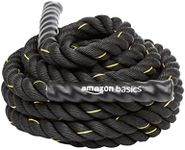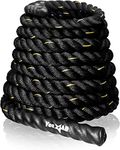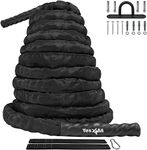Buying Guide for the Best Battle Ropes
Battle ropes are a versatile and effective tool for improving cardiovascular fitness, building muscle, and enhancing overall strength. When choosing the right battle ropes for your needs, it's important to consider several key specifications. These specifications will help you determine which ropes will best suit your fitness level, workout goals, and available space. Understanding these factors will ensure you make an informed decision and get the most out of your battle rope workouts.LengthThe length of battle ropes typically ranges from 30 to 50 feet. Longer ropes (40-50 feet) provide more resistance and are ideal for advanced users looking for a more intense workout. Shorter ropes (30-40 feet) are easier to handle and are suitable for beginners or those with limited space. Consider your fitness level and the space where you'll be using the ropes when choosing the length.
DiameterBattle ropes come in different diameters, usually ranging from 1.5 to 2 inches. Thicker ropes (2 inches) offer more resistance and are better for building strength and muscle. Thinner ropes (1.5 inches) are lighter and easier to grip, making them a good choice for beginners or those focusing on endurance and cardio. Choose a diameter that matches your fitness goals and grip strength.
MaterialBattle ropes are commonly made from poly dacron, manila, or polyester. Poly dacron ropes are durable, flexible, and resistant to fraying, making them a popular choice for most users. Manila ropes are natural and provide a good grip but can shed fibers and wear out faster. Polyester ropes are strong and resistant to moisture, making them suitable for outdoor use. Consider where you'll be using the ropes and your preference for durability and maintenance when selecting the material.
HandlesThe handles of battle ropes are usually covered with heat-shrink caps or rubber to provide a better grip and prevent fraying. Comfortable and secure handles are important for maintaining control during workouts and preventing hand fatigue. Look for handles that are well-covered and provide a good grip, especially if you plan to use the ropes for extended periods.
WeightThe weight of battle ropes is influenced by their length, diameter, and material. Heavier ropes provide more resistance and are better for strength training, while lighter ropes are easier to handle and better for cardio workouts. Consider your fitness goals and current strength level when choosing the weight of your battle ropes. If you're new to battle ropes, starting with a lighter rope and gradually increasing the weight as you build strength is a good approach.







